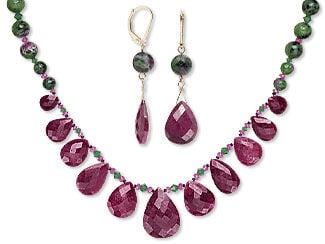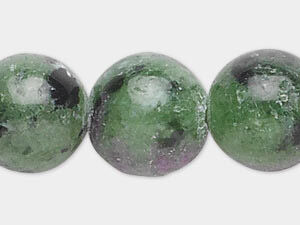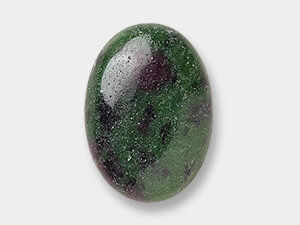Zoisite Meaning and Properties
Zoisite History
Zoisite is a mineral that includes several gem varieties. One form contains an opaque form of ruby (ruby in zoisite). The ruby in zoisite (or ruby zoisite) variety has also been called anyolite, derived from (anyoli)—the Masai tribal word for "green." Other named varieties of this gemstone include the opaque pink-to-red thulite and transparent purplish-blue tanzanite.
This stone was named after an Austrian naturalist and scientist named Sigmund Zois von Edelstein, who identified the stone as being a unique mineral specimen in his extensive collection.
What are the Metaphysical Properties of Zoisite?
Zoisite meaning is linked to returning: return to the self, return to one's center, return to relaxation, return to healthy norms, etc.
The creative energy of zoisite is believed to serve as a reset button, returning the mind back to its objectives after an unwelcome interruption. With ruby in zoisite, artists' lives and their art become one. That's the kind of focused, creative empowerment zoisite is said to give.
For adherents of crystal healing, zoisite meaning is believed to affect disorders of the heart, spleen, pancreas and lungs. The ruby in zoisite (anyolite) variety is said to be especially effective on the cardiovascular system.
When creativity seems to have curled up and died inside you or other things keep pulling you away from the work you love, wearing zoisite is said to work like a mantra, gently calling you back to what you really want to be doing.
Zoisite is affiliated with the astrological sign Gemini, although it is not a formal birthstone. Ruby in zoisite (anyolite) is assigned to the crown chakra, as it is believed to promote individuality while retaining connectiveness.
What is Zoisite Made From?
The green form of zoisite usually includes black veins or inclusions. It is frequently carved into smooth shapes (cabochons, beads and ornamental figures). The green form of zoisite usually includes black veins or inclusions of hornblende. That rich green color, with its red inclusions of ruby, have sometimes led to particular samples being mislabeled as bloodstone. Zoisite shares the chemical composition of the rare transparent gemstone clinzoisite, although they have radically different crystal structures.
Green zoisite and ruby in zoisite are found in Tanzania. Other colors of zoisite are found in Afghanistan, Austria, Cambodia, Kenya, Norway, Madagascar, Pakistan, Sri Lanka and multiple locations within the United States.
- Mineral Information: Calcium aluminum silicate, may include iron or manganese
- Chemical Composition: Ca2Al3(O/OH/SiO4/Si2O7)
- Color: Zoisite with ruby variety: dark green with black inclusions, occasional ruby crystal Other varieties: colorless, white, yellow, brown, blue, green, red, pink (Thulite), purple-blue (Tanzanite)
- Hardness: 6 to 6-1/2 (Mohs)
- Specific Gravity: 2.2 – 2.4
- Refractive Index: 1.69 – 1.70
How Do You Clean Zoisite?
Ruby in zoisite is an easy-to-cleave stone; it will sheer into pieces along very crisp and clear boundaries, much like splitting a dry piece of wood. This also makes ruby in zoisite vulnerable to impact. Even though it is a relatively hard gemstone material, ruby in zoisite shouldn't be exposed to high heat, sharp cold, sudden temperature changes or direct light. Avoid steam and ultrasonic cleaners—plain soapy water and a soft cotton cloth are your best bet.
Zoisite FAQ
Q: What colors and patterns are commonly found in zoisite beads?
A: Zoisite is an umbrella category for several gemstone varieties, including the one called zoisite which is green, ruby-in-zoisite, which is red and green, tanzanite, a purple gemstone and thulite, which is pink and red.
Q: How does zoisite differ from ruby-in-zoisite?
A: Ruby-in-zoisite is exactly what it says it is: raspberry-hued ruby crystals formed inside green zoisite.
Q: Are zoisite beads treated, stabilized or enhanced?
A: Green zoisite and ruby-in-zoisite are not usually treated. Tanzanite, however, is often heat-treated to enhance and stabilize its color.
Designing with Zoisite
Luxurious deep green zoisite with its black inclusions is like a beautiful inlaid treasure chest. The play of red, green and black can be called out by the addition of ruby or black onyx gemstones alongside zoisite. The blend of colors offers a range of design contrast opportunities, too.
A Design Inspiration to Get You Started
Shop for Zoisite
**Please note that all metaphysical or healing properties listed are collected from various sources. This information is offered as a service and not meant to treat medical conditions. Fire Mountain Gems and Beads® does not guarantee the validity of any of these statements.
How did you like this resource? Your feedback helps us provide resources that matter to you most.
Copyright Permissions
All works of authorship (articles, videos, tutorials and other creative works) are from the Fire Mountain Gems and Beads® Collection, and permission to copy is granted for non-commercial educational purposes only. All other reproduction requires written permission. For more information, please email copyrightpermission@firemtn.com.



